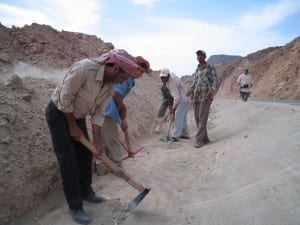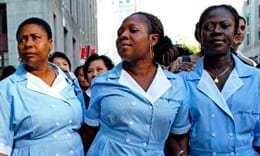May 15, 2013

A wide range of workers are now part of the new Federation of Independent Trade Unions of Jordan (FITU-J).
Nine unions representing more than 7,000 workers recently held the founding congress of the Federation of Independent Trade Unions of Jordan (FITU-J), demonstrating a concrete commitment to independent trade unionism as workers in Jordan seek to mobilize for greater political freedom, improved economic conditions and strong social justice.
The conference theme, “Freedom of Association is a Necessity,” underscored how, as Jordanian workers have participated in multiple labor strikes for the right to form unions over the past four years, they are part of the country’s broader movement for democratic change. Although the Jordanian constitution upholds International Labor Organization (ILO) conventions on freedom of association, Jordanian labor law allows trade unions in only 17 sectors designated by the Ministry of Labor.
During the one-day congress, delegates elected as president Azzam Smadi, retired president of the Independent Phosphates Workers Union. Delegates ratified a constitution and articulated principles and priorities, including the goal to pass legislation expanding access to freedom of association and social security. Conference delegates also demonstrated the importance of involving women in the union movement by establishing the FITU-J women’s committee, headed by Wijdan Abu Ighanam, a member of the independent Electricity Workers Union.
The 218 delegates at the April 26 convention were joined by international guests, including a representative from the United Auto Workers Global Organizing Institute and representatives from the ILO Bureau for Workers’ Activities (ILO-ACTRAV), Public Services International (PSI), and independent unions from Algeria and Kuwait. AFL-CIO President Richard Trumka sent a letter of support and AFL-CIO International Department Director Cathy Feingold taped a video greeting.
The nine participating unions represent workers in the phosphates industry and the pharmaceutical industry and also include electrical workers, land transport drivers, printing press operators, day laborers, agricultural workers, engineers’ assistants and Department of Statistics employees.
May 14, 2013
The Bangladesh cabinet approved a change to the nation’s labor laws that it says would enable workers to more freely form unions. The proposal, which must be approved by Parliament, would allow workers to join unions without showing the list of union supporters to factory owners to verify their employment—a practice that effectively makes it impossible for unions to gather sufficient support to register with the government because factory owners often penalize or fire workers who support unionization.
The move follows an announcement that the Bangladesh government would raise the minimum wage for the nation’s 4 million garment workers. Bangladesh garment workers at minimum are paid $37 a month, the lowest wages in the global garment industry, while often risking their lives just to be at work.
The government’s step toward improving Bangladesh labor laws is welcome, but significant issues remain, says Solidarity Center Asia Regional Director Tim Ryan.
“Registering unions is only part of the difficulty workers experience when they seek to form a trade union,” Ryan says. “In the ready-made garment industry, workers who want to join a union report they face anti-union harassment and discrimination on the job. Until the government takes steps to afford workers their fundamental right of freedom of association by bringing its labor laws into full compliance with international standards, Bangladesh garment workers will not be able to have a voice on the job that they need to improve safety and health conditions.”
Ryan also points to the lack of movement in finding those responsible for the murder of Aminul Islam, a union organizer in the garment sector who was tortured and killed last year. “Finding the perpetrators of those who murdered Aminul and obtaining justice for him would emonstrate that Bangladesh respects the rights of its workers.”
On Monday, major retailers that represent the largest purchasers of clothes made in Bangladesh announced they would help finance safety upgrades at apparel factories. This move follows the collapse of the eight-story Rana Plaza building, which resulted in the world’s worst industrial disaster since the 1984 Bhopal explosion in India. The announcement comes as rescue efforts ended at the site, with the bodies of 1,127 workers recovered from the rubble. The building housed five garment factories.
These actions by the government and brands follow weeks of protests and walkouts by garment workers across the capital, Dhaka, who joined together to demand safe working conditions and wages that can support themselves and their families.
Three factories closed Monday after workers spotted cracks on a wall. They immediately evacuated the building that housed the factories and began protesting outside. After cracks surfaced in the Rana building on April 24, garment workers were told to report to work. Within hours, the building pancaked in on itself.
In Ashulia, near Dhaka, garment makers said yesterday they are indefinitely closing all factories in the area because of worker protests. Workers have been demanding pay increases, benefits and workplace safety for the past 12 days. Ashulia’s more than 300 garment factories account for nearly 20 percent of total garment exports.
Also on Monday, several hundred workers at a ready-made garment factory blocked a road in Mirpur area of the capital for more than two hours, protesting dismissal of 13 co-workers.
Arati Bala Das, 18, was among those pulled from the Rana building after being pinned under a concrete pillar for three days. “When the building collapsed, I felt that I was going down,” she told Solidarity Center staff in Dhaka. “When it stopped, I found myself in the dark. It was difficult to breathe. I could not see anything. I could not move a bit. I realized that two dead bodies had fallen on my legs and a pillar had fallen on those dead bodies. I was very much afraid and I thought I would not be able to return alive.”
Arati’s mother, Titon, was killed in the collapse and Arati’s right leg was amputated. Both worked at New Wave Style Ltd. factory. Her father Adhir Chandra Das, a day laborer, now faces the likely impossible task of supporting Arati and her three young sisters without the additional wages of his wife and eldest daughter.
In November 2012, a fire at Tazreen Fashions killed at least 112 garment workers. Since that blaze, 18 garment workers have died at their workplaces and more than 650 have been injured in 43 fire incidents, according to data compiled by Solidarity Center staff in Dhaka. Just days after the Rana collapse, eight workers were killed at the Tung Hai Sweater Factory.
May 13, 2013

Russian trade unionist Valentin Urusov won the 2013 Svensson Prize for Trade Union Rights. Credit: Russian Confederation of Labor
Valentin Urusov, the Russian electrician and trade unionist unjustly imprisoned for years in a Siberian penal colony, received the international Arthur Svensson Prize for Trade Union Rights in 2013. Urusov led the trade union Profsvoboda at Alrosa, the world’s second largest diamond mining company, based in the northern Sakha province of Russia.
Urusov, who was released from prison in March—after he was nominated for the prize—was jailed in 2008 for allegedly possessing narcotics. However, his arrest coincided suspiciously with preparations for a protest rally by workers at the state-owned Alrosa—a rally which Urusov helped organize. He was sentenced to six years in a penal colony.
In awarding the prize, given by the Norwegian trade union movement, committee chairman Lief Sande said “Urusov has become symbolic of the struggle for workers’ rights and freedom of association in Russia.”
Further, the award committee noted its concern about the workers’ rights situation in Russia, writing, “Freedom of association and the right to strike have long been under pressure, and “it may appear that conditions are deteriorating further.”
The global union, IndustriAll, a strong voice among unions leading the fight for Urusov’s release, congratulated Urusov, calling him a “heroic Russian trade unionist.”
The prize is named for the former leader of the Norwegian Union of Chemical Industry Workers, Arthur Svensson, who was especially engaged in international solidarity.
May 13, 2013

Afro-desendent women gathered in Medellin, Colombia, in April for the first domestic workers union congress. Credit: IDWF
In Colombia, “even when there’s an improvement in the overall economy, women don’t see any improvement,” says Sohely Rua Catañeda. As a result, many women who are unable to secure formal employment are forced into the informal sector to support themselves and their families, laboring as domestic workers or street vendors. Women in these low-paying jobs have limited or no access to social services and are unable to address workplace harassment or unsafe working conditions.
Rua Catañeda, secretary of women and labor at the Escuela Nacional Sindical(National Union School, ENS), Colombia’s pro-worker think tank, recently met with Solidarity Center staff and others to discuss current ENS research on women in the Colombian economy. The Colombian labor market is “a reflection of discrimination,” she says, a statement she bolsters with ENS research that points to cultural factors blocking women’s economic advancement.
Only 8.5 million of the 18.2 million working age women have jobs—compared with 12 million working age men who are employed—and the vast gender gap in workforce participation is largely due a type of cultural discrimination in which employers seek women who fit a certain ideal. And that ideal, says Rua Catañeda, is one that frequently excludes Afro-descendent women, those who are over age 40 and those without the financial resources to buy new clothes or get manicures.
“There’s a lot of pressure for women to invest in their outer appearance for jobs. Afro-descendent women will never have an opportunity for these jobs,” Employers’ preferences for blonde women with straight hair requires women to spend a lot of time “conforming to an image that is really not what we look like.”
Seeking to improve the conditions of low-wage women workers, ENS is working to connect women with unions to strengthen their voice on the job so they can collectively improve wages and working conditions. ENS works closely with the Solidarity Center to support the Afro-Colombian Labor Council (Consejo Labor Afrocolombiano), founded last year by Afro-Colombian labor leaders and Colombian trade unions to advance racial inclusion in the labor movement and in Colombian society. Afro-Colombians comprise more than three-quarters of the country’s poor. Since then, Afro-Colombian women launched the Union of Domestic Service Workers (Unión de Trabajadoras del Servicio Domestíco, UTRASD) in Medellin, the first-ever union in Colombia created entirely by Afro-descendent women.
Rua Catañeda says the first step toward opening the labor market to women is to convey the extent of the problem to the Colombian public. Colombians, who see many women working in public places, think they have plenty of access to jobs, she says. Further, many women’s groups have focused on individualist, entrepreneurial solutions which in the past 10 years have seen few results.
But such solutions have not gone far to address most women’s economic struggles. “What you have are a lot of really tired women who have put a lot of work into their jobs and are poorer than ever before.”
Although recent legislation improving worker rights has passed, Rua Catañeda says technical and other reasons have prevented beneficial legislation from being enforced—making women’s increased membership and involvement in unions all the more critical
May 8, 2013
A stunning 73.4 million young workers are estimated to be jobless in 2013, an increase of 3.5 million between 2007 and 2013, according to an International Labor Organization (ILO) report out today. Even worse, the number of unemployed young workers is likely to increase through 2018, with the long-term impact felt for decades, the report forecasts.
“The youth employment crisis will not be overcome without stronger employment growth,” according to “Global Employment Trends for Youth 2013: A Generation at Risk.” But job growth will not happen on its own. The report urges nations to adopt aggressive policies for improving job growth, including strategies targeting employment of disadvantaged youth. Further, nations must invest in education and training, and ensure labor rights are based on international labor standards “to ensure that young people receive equal treatment and are afforded rights at work.”
“Increasing the participation of young people in employers’ and workers’ organizations and in social dialogue and improving their awareness about young workers’ rights— including through modules in school curricula—are key instruments for enabling young
people to voice their concerns and for improving the quality of jobs available to them.”
Among the report’s findings:
• Young workers are increasingly employed in non-standard jobs, including temporary employment and part-time work. Informal employment accounts for half of young workers in the Russian Federation.
• In 2012, youth unemployment was highest in the Middle East (28.3 percent) and North Africa (23.7 percent) and lowest in East Asia (9.5 per cent) and South Asia (9.3 percent).
• Gender gaps in youth unemployment rates are exceptionally large in the Middle East and North Africa.
• In all developing countries surveyed, more young people receive below-average wages than average or above-average wages. This trend is strongest in Cambodia, Liberia, Malawi and Peru, where two-thirds of working young are classified as poorly paid.
• Young people continue to suffer disproportionately from decent work deficits and low-quality jobs, measured in terms of working poverty, low pay and/or employment status
and exposure to occupational hazards and injury.
Underlying the inability of young workers to find jobs, the report finds, is the persistent unavailability of quality, full-time jobs; the proliferation of temporary jobs; a skills mismatch; and the growth of informal, subsistence jobs in developing countries.
Packed with charts and graphs, the 150-page report also includes case studies highlighting best practices for addressing youth unemployment, including Peru’s job action plan and the dual apprenticeship program offered in some European countries.



